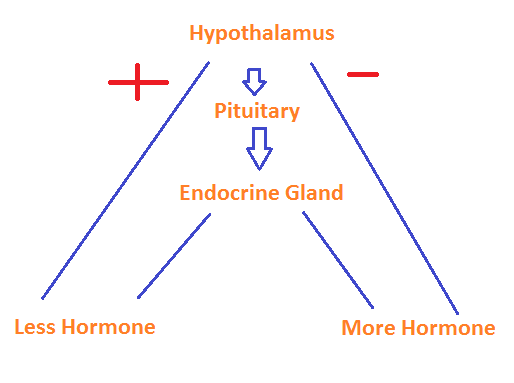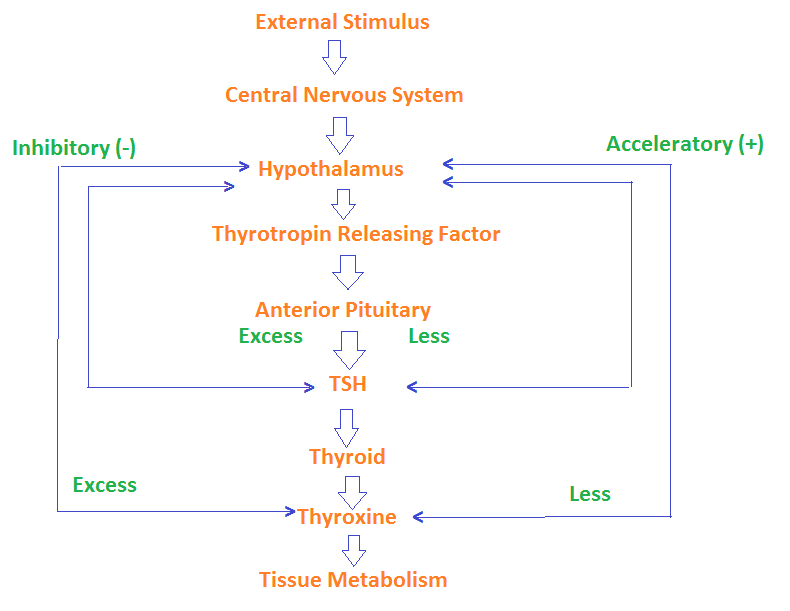Endocrine system maintains homeostasis:

Hormones help in maintaining the internal environment, i.e. homeostasis of the body because their secretions are regulated in a coordinated manner so that the right hormone is secreted at the right time in the right quantity. These secretions of hormones are often under feed-back control by other factors or hormones. Whenever an endocrine gland secretes a hormone in excess, the rise in the blood level of this hormone inhibits the further secretion of stimulating hormone from the pituitary gland. This causes a decline in the secretion of that particular endocrine gland until the blood level of its hormone returns to normal. This is known as a negative feedback mechanism. If the endocrine gland secretes less hormone resulting in a decrease in the blood level of this hormone which stimulates the further secretion of the stimulating hormone from the pituitary and hypothalamus which in turn results in excessive secretion from that endocrine gland. This is known as a positive feedback mechanism.
The feedback system controls the blood level of many hormones in the body. For example–

- The thyrotropin-releasing factor (TRF) from the hypothalamus stimulates the pituitary secretion of thyrotropin or thyroid-stimulating hormone (TSH) and TSH in turn stimulates the thyroid gland to secrete thyroxine. A high amount of Thyroxine in blood exerts an inhibitory influence on the hypothalamus so that the hypothalamus secretes less amount of TRF. This results in a decrease in the TSH secretion and eventually, a decrease in thyroxine secretion. Such inhibitory influence is an example of a negative feedback mechanism. On the other hand, a fall in the blood thyroxine level stimulates the hypothalamus to secrete more of TRF which results in increased secretion of TSH which in turn stimulates increased secretion of thyroxine. This is an example of a positive feedback mechanism.
- ACTH is secreted from the anterior lobe of the pituitary gland under the influence of corticotropin-releasing hormone from the hypothalamus and is carried by the blood, it acts on the cortex of the adrenal gland to cause the production of glucocorticoids. If the level of glucocorticoids in blood increases, this exerts an inhibitory influence on the hypothalamus to produce a less corticotropin-releasing factor. This results in a decrease in ACTH secretion from the anterior pituitary and eventually a decrease in the secretion of glucocorticoids from the adrenal cortex. This is an example of a negative feedback mechanism. On the other hand, a fall in the blood glucocorticoid level stimulates the hypothalamus to secrete more corticotropin-releasing hormone which results in increased secretion of ACTH which in turn stimulates increased secretion of glucocorticoids. This is an example of a positive feedback mechanism.
- Sometimes, the feedback control is exerted by a metabolite. The output of the pancreatic hormone insulin depends on the level of glucose in the blood. After a meal, a sudden release of glucose from the intestine to the blood occurs. The increased level of glucose in the blood stimulates the secretion of insulin. Insulin then lowers the level of blood glucose to normal again. A fall in blood sugar, on the other hand, removes this stimulatory influence of glucose on insulin secretion so that the level of blood sugar is prevented from falling further. This helps in the maintenance of blood sugar homeostasis by insulin.
- Constituents Of Air And Their Uses
- Air Pollution- Causes, Effects, and Control Measures
- Water Pollution- Causes, Effects, and Control Measures
- Solid Waste Management
- Applications Of Laser And Maser
- Uses of Washing Soda, Bleaching Powder, etc.
- Plant and Animal Cell
- Mitosis: Process and Significance
- Meiosis: Process and Significance
- Theories of Evolution: From Tamil Board Book









Comments (No)